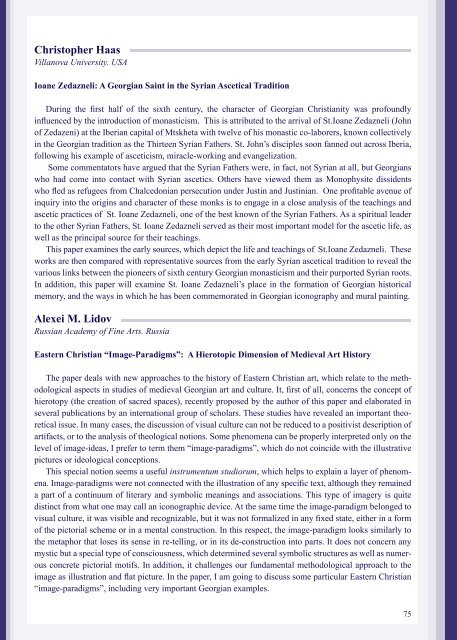Abstracts - International Initiative for Georgian Cultural Studies
Abstracts - International Initiative for Georgian Cultural Studies
Abstracts - International Initiative for Georgian Cultural Studies
Create successful ePaper yourself
Turn your PDF publications into a flip-book with our unique Google optimized e-Paper software.
Christopher Haas<br />
Villanova University. USA<br />
Ioane Zedazneli: A <strong>Georgian</strong> Saint in the Syrian Ascetical Tradition<br />
During the first half of the sixth century, the character of <strong>Georgian</strong> Christianity was profoundly<br />
influenced by the introduction of monasticism. This is attributed to the arrival of St.Ioane Zedazneli (John<br />
of Zedazeni) at the Iberian capital of Mtskheta with twelve of his monastic co-laborers, known collectively<br />
in the <strong>Georgian</strong> tradition as the Thirteen Syrian Fathers. St. John’s disciples soon fanned out across Iberia,<br />
following his example of asceticism, miracle-working and evangelization.<br />
Some commentators have argued that the Syrian Fathers were, in fact, not Syrian at all, but <strong>Georgian</strong>s<br />
who had come into contact with Syrian ascetics. Others have viewed them as Monophysite dissidents<br />
who fled as refugees from Chalcedonian persecution under Justin and Justinian. One profitable avenue of<br />
inquiry into the origins and character of these monks is to engage in a close analysis of the teachings and<br />
ascetic practices of St. Ioane Zedazneli, one of the best known of the Syrian Fathers. As a spiritual leader<br />
to the other Syrian Fathers, St. Ioane Zedazneli served as their most important model <strong>for</strong> the ascetic life, as<br />
well as the principal source <strong>for</strong> their teachings.<br />
This paper examines the early sources, which depict the life and teachings of St.Ioane Zedazneli. These<br />
works are then compared with representative sources from the early Syrian ascetical tradition to reveal the<br />
various links between the pioneers of sixth century <strong>Georgian</strong> monasticism and their purported Syrian roots.<br />
In addition, this paper will examine St. Ioane Zedazneli’s place in the <strong>for</strong>mation of <strong>Georgian</strong> historical<br />
memory, and the ways in which he has been commemorated in <strong>Georgian</strong> iconography and mural painting.<br />
Alexei M. Lidov<br />
Russian Academy of Fine Arts. Russia<br />
Eastern Christian “Image-Paradigms”: A Hierotopic Dimension of Medieval Art History<br />
The paper deals with new approaches to the history of Eastern Christian art, which relate to the methodological<br />
aspects in studies of medieval <strong>Georgian</strong> art and culture. It, first of all, concerns the concept of<br />
hierotopy (the creation of sacred spaces), recently proposed by the author of this paper and elaborated in<br />
several publications by an international group of scholars. These studies have revealed an important theoretical<br />
issue. In many cases, the discussion of visual culture can not be reduced to a positivist description of<br />
artifacts, or to the analysis of theological notions. Some phenomena can be properly interpreted only on the<br />
level of image-ideas, I prefer to term them “image-paradigms”, which do not coincide with the illustrative<br />
pictures or ideological conceptions.<br />
This special notion seems a useful instrumentum studiorum, which helps to explain a layer of phenomena.<br />
Image-paradigms were not connected with the illustration of any specific text, although they remained<br />
a part of a continuum of literary and symbolic meanings and associations. This type of imagery is quite<br />
distinct from what one may call an iconographic device. At the same time the image-paradigm belonged to<br />
visual culture, it was visible and recognizable, but it was not <strong>for</strong>malized in any fixed state, either in a <strong>for</strong>m<br />
of the pictorial scheme or in a mental construction. In this respect, the image-paradigm looks similarly to<br />
the metaphor that loses its sense in re-telling, or in its de-construction into parts. It does not concern any<br />
mystic but a special type of consciousness, which determined several symbolic structures as well as numerous<br />
concrete pictorial motifs. In addition, it challenges our fundamental methodological approach to the<br />
image as illustration and flat picture. In the paper, I am going to discuss some particular Eastern Christian<br />
“image-paradigms”, including very important <strong>Georgian</strong> examples.<br />
75



